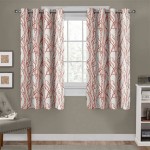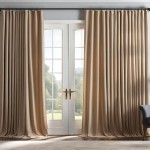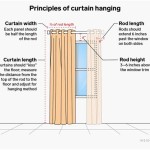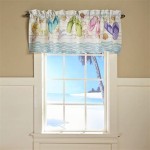Determining the Appropriate Curtain Rod Length for Optimal Window Treatment
The selection of an accurately sized curtain rod is a critical component in achieving aesthetically pleasing and functionally effective window treatments. An improperly sized rod can detract from the overall appearance of a room, compromise privacy, and hinder the smooth operation of curtains or drapes. This article elucidates the factors that influence the ideal curtain rod length and provides practical guidance for accurate measurement and selection.
Understanding the Functionality and Aesthetics of Curtain Rod Placement
The length of a curtain rod directly impacts both the functional performance and visual appeal of window treatments. Functionally, the rod must be long enough to allow the curtains to be fully drawn open, maximizing natural light and preventing obstruction of the window pane. Aesthetically, the rod's length contributes to the perceived size and proportions of the window and the room. A rod that extends beyond the window frame can create the illusion of a larger window and a more spacious interior. Conversely, a rod that is too short can make the window appear smaller and cramped.
The intended style and material of the curtains also influence the necessary rod length. Heavier fabrics, such as velvet or blackout materials, require a sturdier rod that extends further beyond the window frame to properly support the weight and ensure smooth traversing. Lighter fabrics, like sheer or linen, may require less extension. The type of curtain heading, whether it be grommets, pleats, or rod pockets, also affects the final aesthetic and functional requirements.
Furthermore, the desired light control and privacy levels should be considered. If complete blackout is desired, the rod should extend significantly beyond the window frame to minimize light leakage around the edges of the curtains. Similarly, to maximize privacy, the rod should be positioned to ensure full coverage of the window when the curtains are closed.
Key Measurement Considerations for Accurate Rod Length Determination
Accurate measurement is paramount in determining the correct curtain rod length. The following steps outline a systematic approach to ensure precise measurements:
1. Window Width Measurement: The first step is to measure the width of the window frame. This measurement serves as a baseline for determining the minimum rod length. Use a metal measuring tape for accuracy. Avoid fabric or flexible measuring tapes, as they can stretch and provide inaccurate readings.
2. Extension Beyond the Window Frame: The ideal curtain rod length typically extends beyond the window frame on each side. The amount of extension depends on the desired aesthetic and functional goals. As a general guideline, extending the rod 3 to 6 inches beyond the frame on each side is common. This allows the curtains to be fully drawn open without obscuring the window, maximizing light and visibility.
3. Height Above the Window Frame: The height at which the curtain rod is mounted above the window frame also influences the perceived height of the room. Mounting the rod higher than the window frame creates the illusion of taller ceilings. A common recommendation is to mount the rod approximately 4 to 6 inches above the top of the window frame. However, this can be adjusted based on the overall room proportions and desired aesthetic. For rooms with lower ceilings, mounting the rod closer to the ceiling can visually elongate the space.
4. Obstructions and Architectural Features: Before finalizing the rod length, it is essential to consider any obstructions or architectural features that may impact placement. These may include window trim, molding, light fixtures, or built-in shelving. Adjustments to the rod length may be necessary to avoid these obstructions and ensure proper functionality.
5. Bracket Placement: The placement of the curtain rod brackets is crucial for stability and support. The brackets should be securely mounted to the wall, preferably into studs or with the use of appropriate wall anchors. The placement of the brackets will dictate the final rod length, as the rod must extend beyond the brackets to allow for proper curtain movement. Ensure that the chosen brackets are compatible with the diameter of the curtain rod.
6. Curtains Fullness: The fullness of curtains plays a significant role in the length of your curtain rod. Fullness refers to the amount of fabric used compared to the width of the window. Curtains with greater fullness require longer rods to accommodate the extra fabric when they are drawn open.
7. Consider Return Depth: The return depth refers to the distance from the front of the curtain to the wall. This depth is important for light control and privacy. A rod that isn't long enough may not provide the necessary return depth to block out light. Wrap-around curtain rods offer increased return depth for enhanced light blocking.
8. Use a Level: Before you start drilling holes for the brackets, ensure the rod is level. This is essential for the curtains to hang evenly. Use a level to mark the positions for your brackets accurately.
By carefully considering these measurement considerations, a homeowner or decorator can confidently determine the appropriate curtain rod length for their specific needs.
Selecting the Right Type of Curtain Rod for Optimal Performance
The choice of curtain rod type is as important as the measurement itself. Different types of rods are designed for specific purposes and aesthetic preferences. Choosing the right type will ensure optimal performance and enhance the overall appearance of the window treatment.
1. Standard Curtain Rods: Standard curtain rods are the most common type and are suitable for a wide range of curtain styles and weights. These rods typically consist of a single metal or wooden pole that is supported by brackets. They are available in various diameters and finishes to complement different decor styles. Standard rods are often used with rod pocket curtains, grommet curtains, or tab top curtains.
2. Traverse Rods: Traverse rods are designed for curtains that are opened and closed using a cord or wand. These rods feature a track along which carriers move, allowing the curtains to be drawn smoothly and evenly. Traverse rods are particularly well-suited for heavy curtains or drapes that require substantial support. They are often used in formal settings or in rooms where light control and privacy are paramount.
3. Tension Rods: Tension rods are spring-loaded rods that are held in place by tension between two surfaces. These rods are easy to install and require no drilling or hardware. Tension rods are commonly used for lightweight curtains or sheer panels in bathrooms, kitchens, or other small spaces. However, they are not suitable for heavy curtains or drapes due to their limited weight capacity.
4. Decorative Rods: Decorative rods are designed to be visually appealing and to complement the overall decor of the room. These rods often feature ornate finials, decorative brackets, and unique finishes. Decorative rods are typically used with curtains that are hung from rings or clips, allowing the rod to be visible and contribute to the overall aesthetic.
5. Double Curtain Rods: Double curtain rods, as the name suggests, consist of two rods mounted one in front of the other. This type of rod allows for layering of curtains, such as pairing sheer curtains with blackout curtains. This provides flexibility in light control and privacy. They are often used to create interest and to add depth to window treatments.
6. Café Rods: Café rods are typically smaller in diameter and are designed to be hung in the middle of the window frame. They are often used with café curtains, which cover only the lower portion of the window. Cafe rods provide privacy while still allowing natural light to enter the room. They are a popular choice for kitchens and bathrooms.
7. Sash Rods: Sash rods are designed to be mounted directly onto the window sash, typically using small brackets or adhesive strips. These rods are commonly used with lightweight curtains or sheer panels in doors or windows that are frequently opened and closed. They are a simple and unobtrusive option for adding privacy and light control.
8. Track Systems: Curtain track systems offer a more streamlined and customizable option for hanging curtains. These systems consist of a track that is mounted to the ceiling or wall, along with carriers or gliders that attach to the curtains. Track systems allow for smooth and effortless traversing of curtains, and they are often used in modern or minimalist designs. They can be particularly useful in situations where windows are unusually large or have unconventional shapes.
By carefully considering the weight, style, and functionality of the intended curtains, and by selecting the appropriate type of curtain rod, one can ensure optimal performance and enhance the overall aesthetic of the window treatment.
Ultimately, determining the appropriate curtain rod length is a multifaceted process that requires careful consideration of various factors. By accurately measuring the window, accounting for desired extension, and selecting the right type of rod, individuals can achieve window treatments that are both visually appealing and functionally effective.

How To Measure For Curtain Rods 4 Easy Steps

Measuring For Poles 50 Off Blinds Direct

How To Measure A Window For Curtains

How To Hang Curtains Look Their Best The Shade

Drapery Measuring Instruction Twopages Curtains

Curtain Pole Measurement Guide Poles Direct

How To Hang Curtains Like A Pro Diy Darling

How Far Past A Window Should Curtains Go
How To Hang Curtains In 7 Steps

Hanging Curtains You Re Probably Doing It Wrong Ask The Expert Style Boston Com Real Estate








